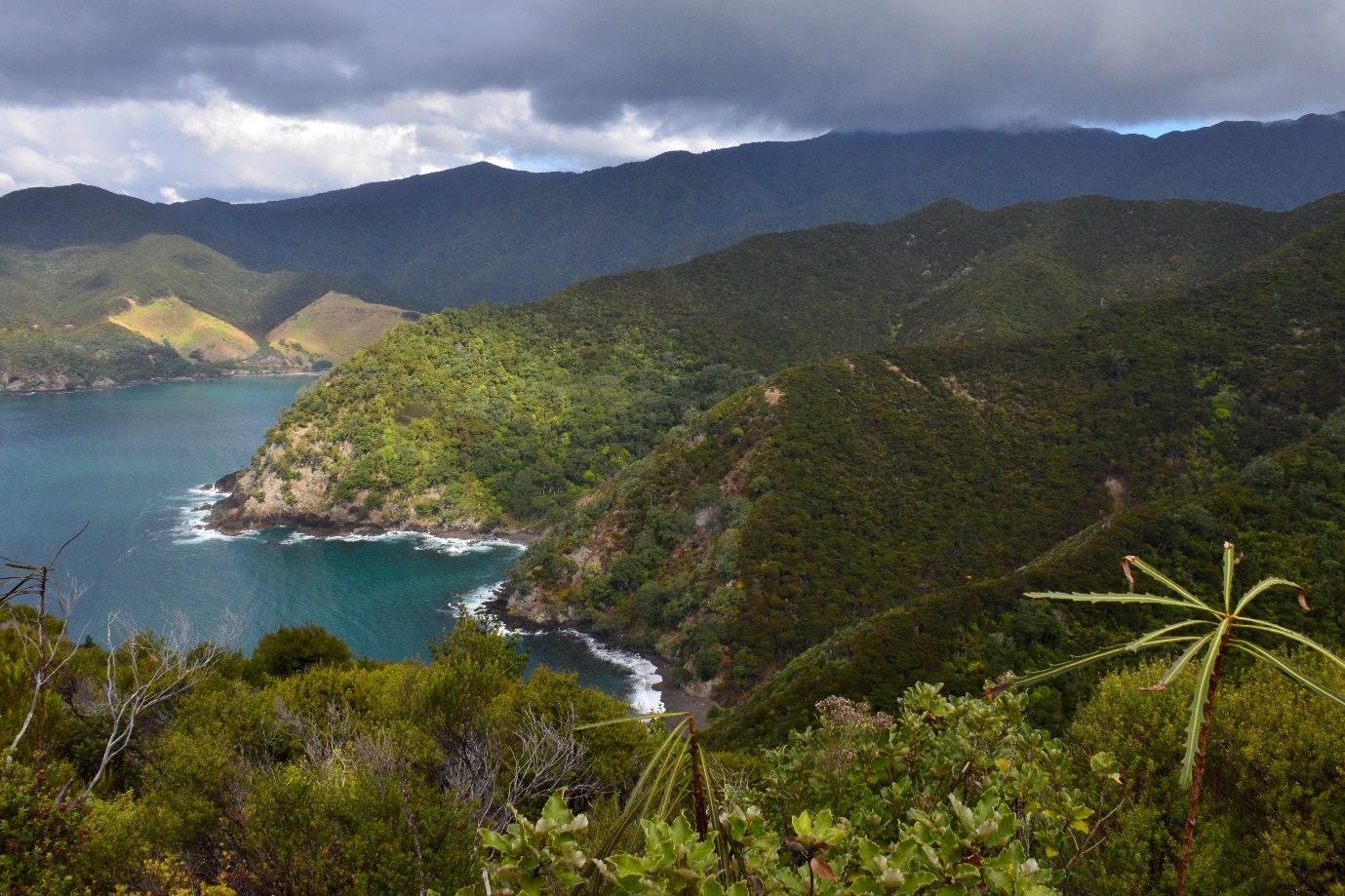
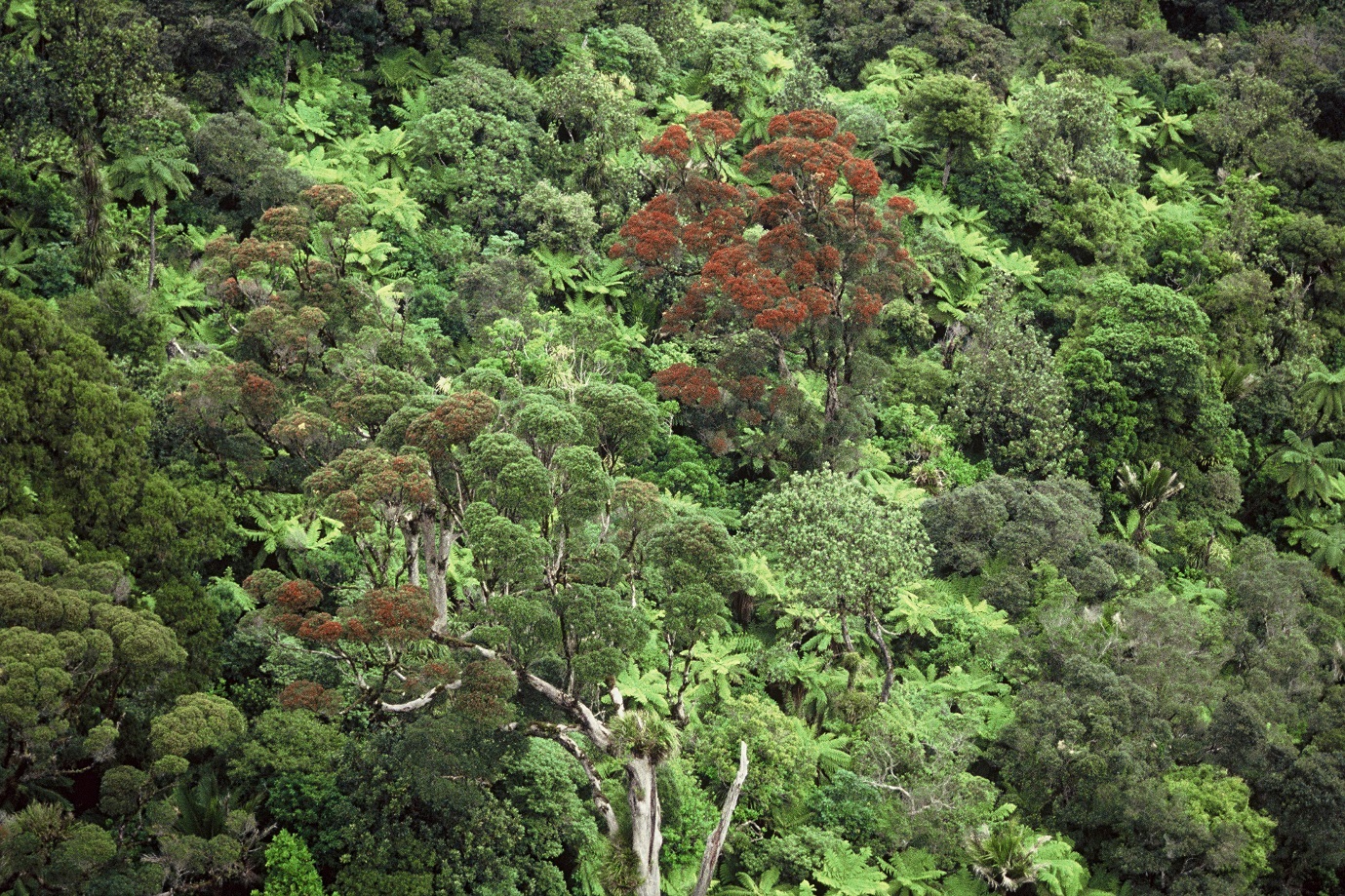
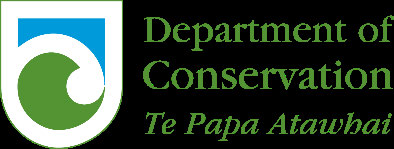 Aerial 1080 Operational Plan
Moehau 2021
Aerial 1080 Operational Plan
Moehau 2021
1982
Act
Information
Official
the
under
Released
Contents
Section A Project management .............................................................................................................. 3
1. Project scope .............................................................................................................................. 3
2. Summary table of key documents ............................................................................................. 3
3. Objectives and targets ............................................................................................................... 4
4. Project team ............................................................................................................................... 5 1982
5. Contracts .................................................................................................................................... 9
6. Consents required ...................................................................................................................... 9
Act
7. Consultation ............................................................................................................................... 9
8. Monitoring ............................................................................................................................... 10
9. Timeline and Milestones .......................................................................................................... 10
10. Project risks and mitigation ..................................................................................................... 11
11. Project debrief and reporting .................................................................................................. 11
12. Project Compliance register ..................................................................................................... 11
Section B Operational ........................................................................................................................... 12
13. Site description ........................................................................................................................ 12
14. Control Design .......................................................................................................................... 18
Information
15. Method(s) ................................................................................................................................. 18
16. Block and treatment area boundaries ..................................................................................... 18
17. Loading sites & other set up .................................................................................................... 21
18. Security ..................................................................................................................................... 21
19. Public safety ............................................................................................................................. 21
Official
20. Bait, storage and transport ...................................................................................................... 21
21. Incidents and emergencies ...................................................................................................... 22
the
22. Decision making on the day of bait application ....................................................................... 22
23. Bait spreading .......................................................................................................................... 22
24. Demobilisation ......................................................................................................................... 23
Section C Project Task List ........................................................................
Error! Bookmark not defined. Section D Task specifications ................................................................................................................ 24
under
Action Plan Schedule for bait application days ....................................
Error! Bookmark not defined. Installl warning signs ................................................................................................................... 24
Check warning signs ..................................................................................................................... 25
Establish Loading site ................................................................................................................... 26
Aerial Contractor Planning Visit ................................................................................................ 27
Track and Road Clearing ............................................................................................................. 28
Check at Bio huts ..............................................................................
Error! Bookmark not defined.
Released
Carcass and Bait Monitoring ....................................................................................................... 29
2
Moehau Moehau Operational plan
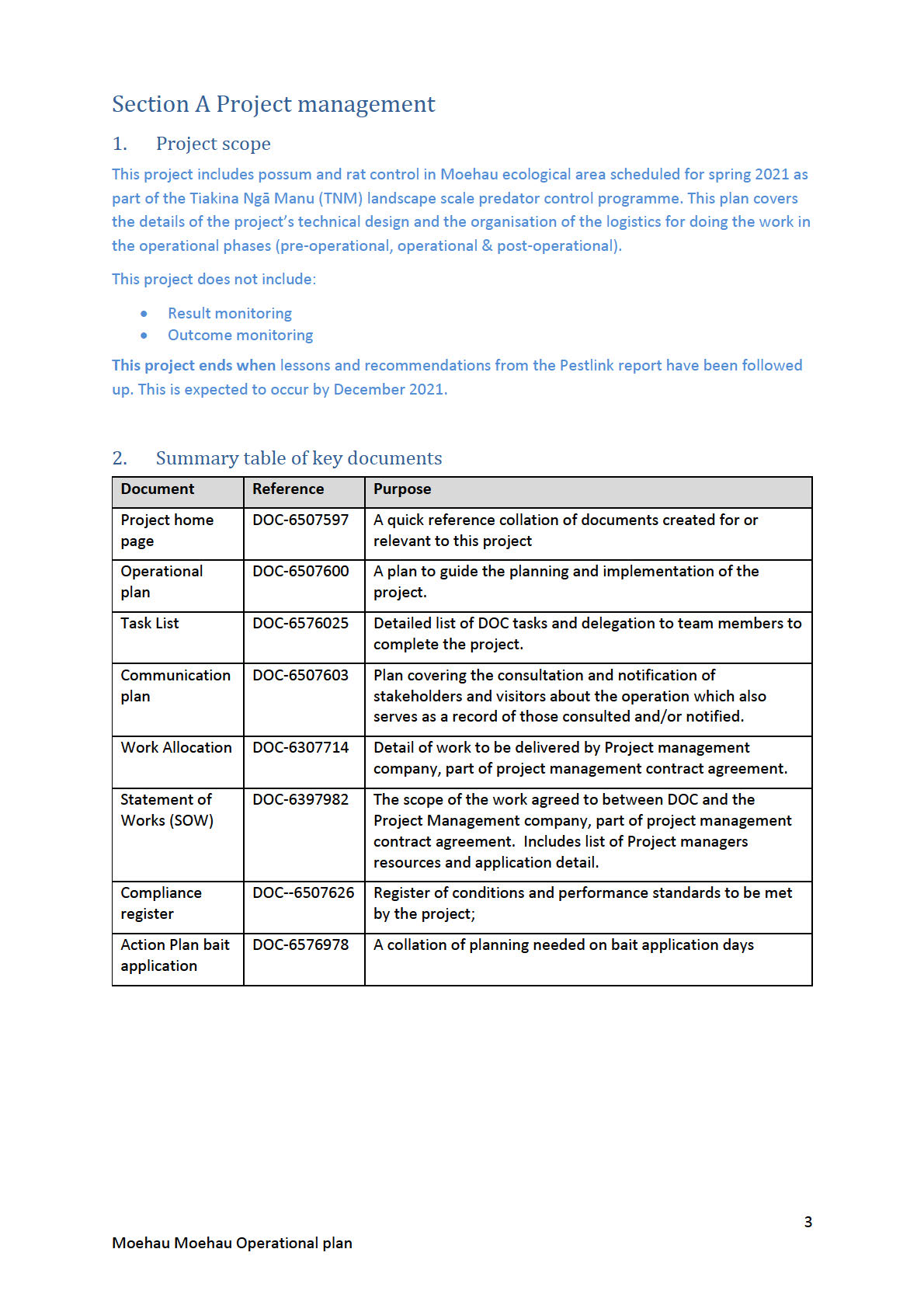
1982
Act
Information
Official
the
under
Released
3. Objectives and targets
Outcome target
To protect and maintain the health and integrity of the forest community within this ecosystem Forest health wil be assessed using possum susceptible species as indicators.
To improve the breeding success of North Island Robin, Kereru, North Island Kaka, and to protect
Archeys and Hochstetters frogs
Result target
The result targets for this operation will be:
1982
• a residual wax tag index of less than 1% (2 possums per 100 wax tag-nights) by 30
November 2021.
• Tracking tunnel index for rats less than 5% by November 2021
Act
Information
Official
the
under
Released
4
Moehau Moehau Operational plan
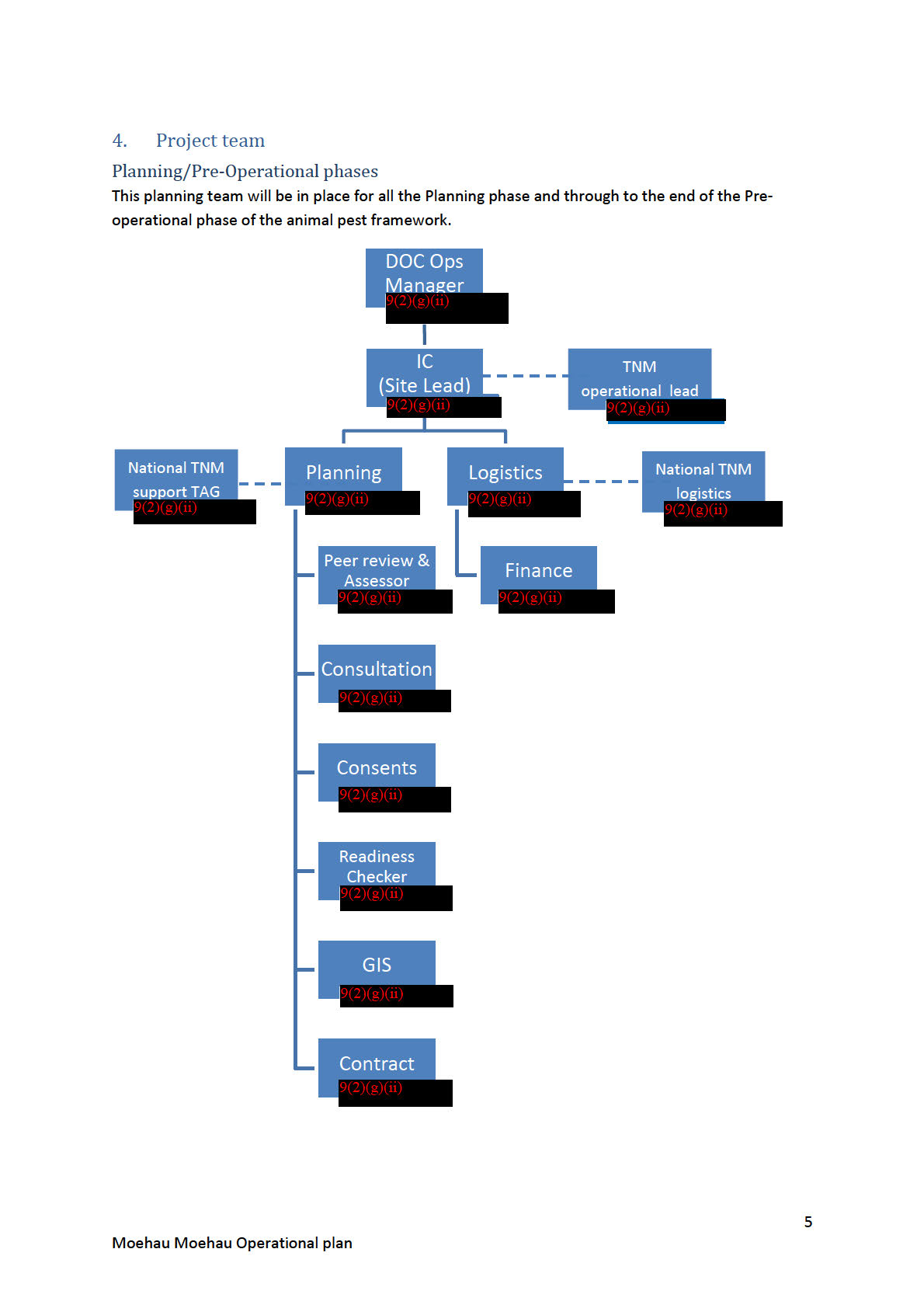
1982
Act
Information
Official
the
under
Released
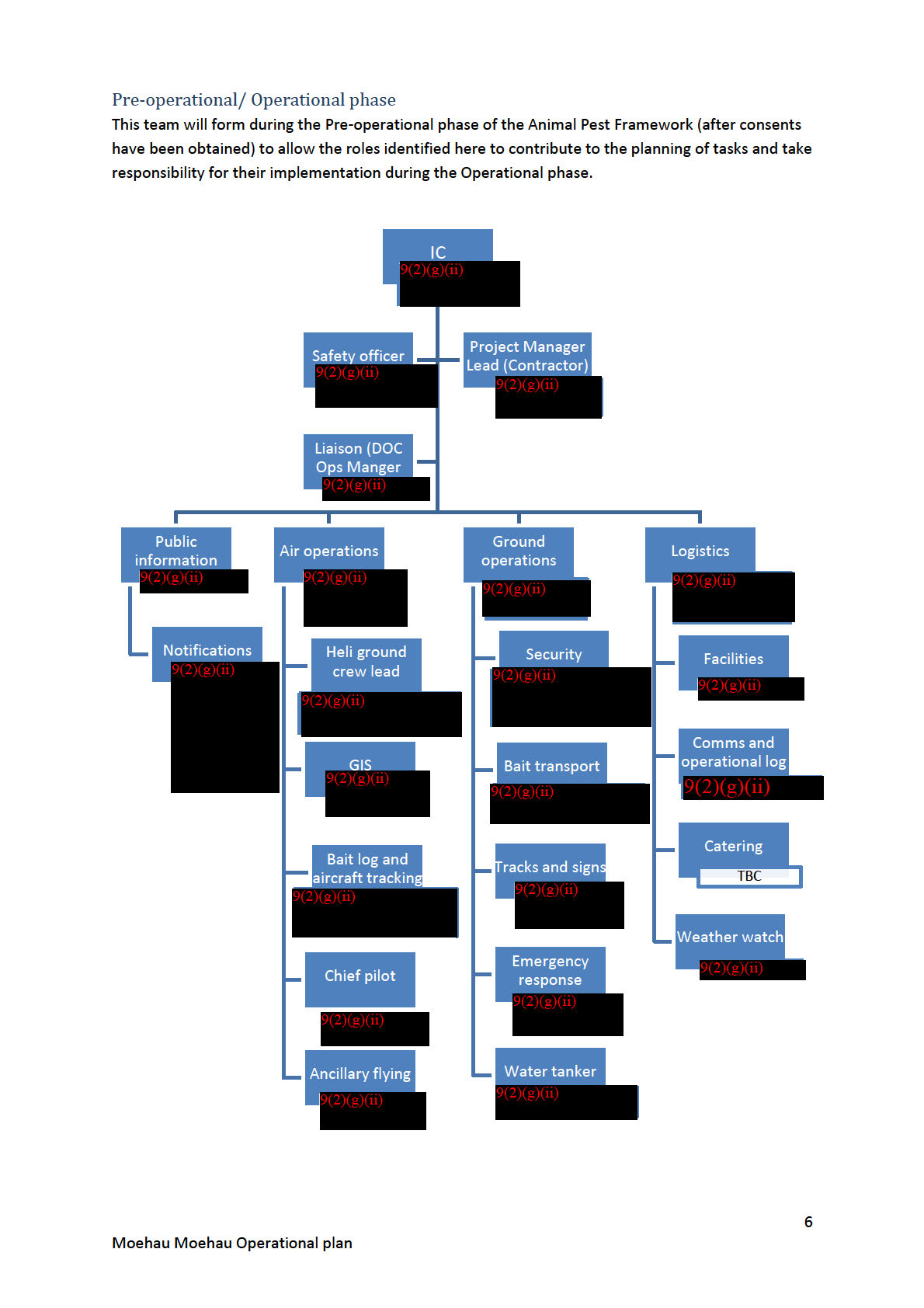
1982
Act
Information
Official
the
under
Released
Key Roles and Responsibilities
Title
Role
Responsibilities
Incident Controller Take charge and lead the project Ensure Task Assignment, Work
Allocation & SOW is fulfilled as agreed
to deliver project outcomes
Project Manager
Plan and deliver the operation on Deliver all phases of the operation
Lead
behalf of DOC
detailed in the SOW and Work
Allocation to the standards required.
1982
Planning Manager Ensure project is planned to DOC Plans, manages and reports on
SOP standards
operation using Operational Planning
for Pest Operations SOP docdm-Act
1488532.
Air Operations
Supervise aerial baiting delivery
Manage aircraft loading, bait and
Manager
contract
sowing information to ensure aerial
baiting is safely completed to standard.
Ground Operations Supervise implementation not
Manage ground-based tasks identified,
Manager
covered by air operations
specified and delegated in operational
plan.
Logistics Manager
Provide logistical supplies
Manage logistical tasks identified,
requested.
specified and delegated in operational
Information
plan
GIS Technician
Provide mapping services to
GIS mapping required during planning
support the planning and delivery and implementation. Analysis and
of the project
presentation of bait spread data.
Support and mentoring for correct use
of Pesticides App.
Official
Peer Reviewer
To support the operational
Provides a written independent review
planner with independent
of the operational plan in Planning
the
comments and questions early in phase Step 3 before consents are
the process, when there is stil
obtained.
flexibility for significant changes if
necessary.
Readiness checker To independently review al
Reviews the operational plan and
under
planning to assess readiness for
associated documents in Pre-
the Operational phase.
Operational phase Step 7 in order to
identify non-compliance, gaps and
risks. Works with the operational
planner to develop a plan to remedy
the priority issues before the operation
goes ahead.
Regional TNM Lead To coordinate and support TNM
Monitor progress, mentor and support
Released operations across Regions. site leads. Troubleshoot and build
capacity. Transfer lessons to/from
other operations.
7
Moehau Moehau Operational plan
National TNM
Provide Nationally contracted
Bait supply, aerial works contractors,
Logistics
services and supplies to
bucket calibrations, National security
operations.
contracts.
National TNM TAG Support TNM programme with
Maintain best practice guidance.
technical advice.
Respond to specific technical
questions.
Safety Officer
Oversee safe working
Support, mentor and audit the delivery
environment and practices.
of safety in the workplace.
Emergency
Plan and if necessary, deliver a
Provide emergency pre-plans relevant
Response Lead
response to incidents arising
to the risks identified for this
1982
during implementation
operation. Form the nucleus of a ready
reaction team capable of responding to
most likely incidents.
Act
Security
Supervise security contract.
Advise, plan and deliver security to
prevent or limit disruption of operation
and risks to staff safety
Information
Official
the
under
Released
8
Moehau Moehau Operational plan
5. Contracts
9(2)(g)(ii)
have been contracted to project manage this operation.
h
9(2)(g)(ii)
ave sub-contracted 9(2)(g)(ii)
9(2)(g)(ii) to undertake the aerial application of bait and 9(2)(g)(ii)
to transport the bait
9(2)(g)(ii)
to the loading site9(2)(g)(ii)
9(2)(g)(ii)
9(2)(g)(ii)
to provide security at the loading zone9(2)(g)(ii)
are approved contractors on
the TNM national contractor panel.
9(2)(g)(ii)
worked on this block previously, in the 2012/13 operation, under contract to DOC.
TNM logistics will order the bait and have it transported from the factory to the 9(2)(g)(ii) store in
9(2)(g)(ii)
1982
9(2)(g)(ii)
9(2)(g)(ii)
the lead 9(2)(g)(ii)
will liaise with 9(2)(g)(ii) , Site Lead for DOC.
will
supervise the contract and ensure that all standards are met. Contract details are described in the
Act
Work Allocation DOC-6307714
and SOW DOC-6397982
6. Consents required
Public Health Permission is required from Waikato District Health Board to apply the toxic bait.
DOC permission is required 9(2)(g)(ii)
. The
application will be assessed by 9(2)(g)(ii)
TNM Operations Support.
9(2)(g)(ii)
Information
Consents from Thames Coromandel District Council are required for treating paper roads within the
treatment area. The council consents wil be obtained by DOC.
Official
7. Consultation
Iwi
the
Relevant consultation and engagement are with all Iwi within the Hauraki Collective
• Ngāi Tai ki Tamaki
• Ngāti Hako under
• Ngāti Hei
• Ngāti Maru
• Ngati Pāoa
• Ngāti Porou ki Hauraki
• Ngāti Pūkenga
• Ngāti Rāhiri Tumutumu
Released
• Ngāti Tamaterā
• Ngāti Tara Tokanui
• Ngāti Whanaunga
• Te Patukirikiri
9
Moehau Moehau Operational plan
As well as other Iwi/hapu who that have interest in the area
• Ngati Huarere
• Ngati Rongo U
This will include meetings, visits, phone calls and emails.
Adjoining landowners/occupiers
1982
9(2)(g)(ii)
Act
Key stakeholder groups
9(2)
pig hunting groups 9(2)(a)
have interest in this area for pig
h(unti
)(ii) ng.
8. Monitoring
Information
Water monitoring will only take place if required by Waikato Health and /or landowners that are
taking drinking water with the operational block have requested it.
Pre-Operational possum monitor will be carried out by a contractor selected from the TNM
monitoring panel this monitor we be using wax tags over 10 lines to NPCA standards within the
Moehau operational area.
Official
A rat monitor will be carried out by staff using 140 tracking tunnels spread over 14 lines.
the
9. Timeline and Milestones
This project aims to protect native flora and fauna from rats, possums and stoats. To achieve this the
toxic baiting is scheduled to take place July to October of that year. To achieve this the project must
be ready for implementation (prefeed baiting) by 1 July. From this timeframe the following
under
milestones are derived for the project:
1. Planning phase of Animal Pest framework complete
2. Pre-Operational Phase of Animal Pest Framework complete by 30 June 2021
3. Prefeed baiting complete by 1st September 2021
4. Toxic baiting complete by 1st October 2021
5. Operational Report complete by 15th December 2021
Released
10
Moehau Moehau Operational plan
10. Project risks and mitigation
Risk
Consequence Likelihood
Mitigation
Weather
Delay
Moderate
Timing of the operation will be important as
prolonging operation,
if left too late end September early October
operations second pre-
the weather patterns can be very un-
feed
predictable
required
Protesters
Delay
High
Work with TNM security team, NZ Police
operation
and contractor
1982
Bait to site Delay
High
Transport plan and work with TNM security
operation
team, NZ Police and contractor
Contractor Delay
Moderate
Good communication and working closely
Act
availability operation
with the contractor monthly meetings
11. Project debrief and reporting
An operational debrief will be carried out on completion of the pre-feed application, and prior to the
toxic run and a final debrief will be carried out within 3 weeks of completion of the toxic application
Information
A Pestlink report for this project wil be prepared and verified within 5 months of the completion of
bait application 9(2)(g)(ii)
12. Project Compliance register Official
DOC-6507626
the
under
Released
11
Moehau Moehau Operational plan
Section B Operational
13. Site description
Moehau mountain is sacred to local iwi, its full name is Te Moengahau-o-Tamatekapua – the windy
sleeping place of Tamatekapua, the Te Arawa chief and steersman who had a strong association with
the mountain.
The summit of Moehau is the burial place of the great chief Tamatekapua who arrived in New
Zealand with the first Polynesian navigators. The prow of his canoe is said to have been laid with him
on Moehau.
1982
With other iwi having strong connection and association with Moehau.
There are numerous Pa sites and middens on the coastal headlands and beaches surrounding
Act
Moehau, during the musket wars local tribes fought on these beaches and headlands, many of these
sites are now Wahi Tapu.
An amazing variety of unique and rare plants and animals live here sharing a diverse range of
habitats from coastal cliffs to sub-alpine grasslands. Moehau contains coastal pōhutukawa, kauri,
tawa (
Beilschmiedia tawa) and podocarp forests, within lowland and montane bioclimatic zones.
Within Moehau forest can be found internationally significant ecological values including locally
endemic Weta and stag beetles, Archey and Hochstetters frog, Coromandel striped gecko, Pateke
(Brown Teal), Kaka, Bellbird, Grey Warbler, Kakariki (parakeets), Brown Kiwi, Long tailed and Shining
Information
cuckoo, North Island Robin, Kereru and Morepork.
Moehau is the northern limit for many southern montane species such as mountain toatoa and
mountain cedar (pahautea). Moehau requires ongoing protection for national y threatened and
regionally rare plant species. Flora values include
Peraxil a tetrapetala (Red mistletoe),
Prasophyl um
hectori (swamp leek orchid),
Caladenia bartletti , Pittosporum virgatum, Celmisia incana, Veronica
Official
punicea (Hebe
) and Brachyglottis kirki var. kirki (Kirk's daisy).
Land form values include the nationally unique Paritu pluton, a geographical feature of volcanic
the
origin. Wind and rain sculpture the rugged peak of Moehau that rises steeply from the sea. At 892m
it is the highest point on the Coromandel Peninsula.
Conservation Values
Moehau is a notable area which has been identified under the Natural Heritage Management
under
System (NHMS) as a high priority site. This area is prioritised for management because of the high
conservation values. In some instances, this relates to threatened biodiversity such the nationally
vulnerable Coromandel Brown Kiwi
Apteryx mantel i. In other cases, there are unique ecosystems
present, such as the sub-alpine grasslands at the top.
Threatened species Coromandel brown kiwi
Released
Coromandel Brown Kiwi (CBK) are present in the operational area. CBK’s are the rarest of the North
Island brown kiwi taxa with an estimated 1700 birds across the Coromandel. Kiwi densities are
highest in the northern regions of the Peninsula, making Moehau an important area for CBK.
12
Moehau Moehau Operational plan
North Island Robin
About 100 North Island Robin from Pureora Forest park were released into the Moehau area, 61 of
those birds were released on public conservation land on the eastern side of Mt Moehau at Stony
Bay in 2009 and 2011. 30 birds were released in 2009 on 300 ha of privately owned land just south
of Stony Bay. Moehau is the only place in the Coromandel region to have North Island Robin.
Long-tailed bats
1982
Long-tailed bats have been found in the Moehau ecological area and are likely the only native land
mammal on the Coromandel. Searches continue for short-tailed bats, but none have been found to
date.
Act
Threatened plants
Brachyglottis kirki var. kirkii (Kirk's daisy) At Risk – Declining
Peraxil a tetrapetala (Red mistletoe) At Risk - Declining
Information
Prasophyl um hectori (swamp leek orchid) At Risk - Declining
Caladenia bartletti At Risk - Naturally Uncommon
Official
Pittosporum virgatum At Risk - Naturally Uncommon
the
Veronica punicea (Hebe)
At Risk - Naturally Uncommon
Archey’s frog under
The Coromandel Peninsula is home to much of the threatened Archey’s frog range. The only other
places they are found include a small coastal forest block in the King Country, Maungatautari and
captive facilities such as the Auckland Zoo. The Coromandel represents the national stronghold for
Archey’s frog (see below).
Released
13
Moehau Moehau Operational plan
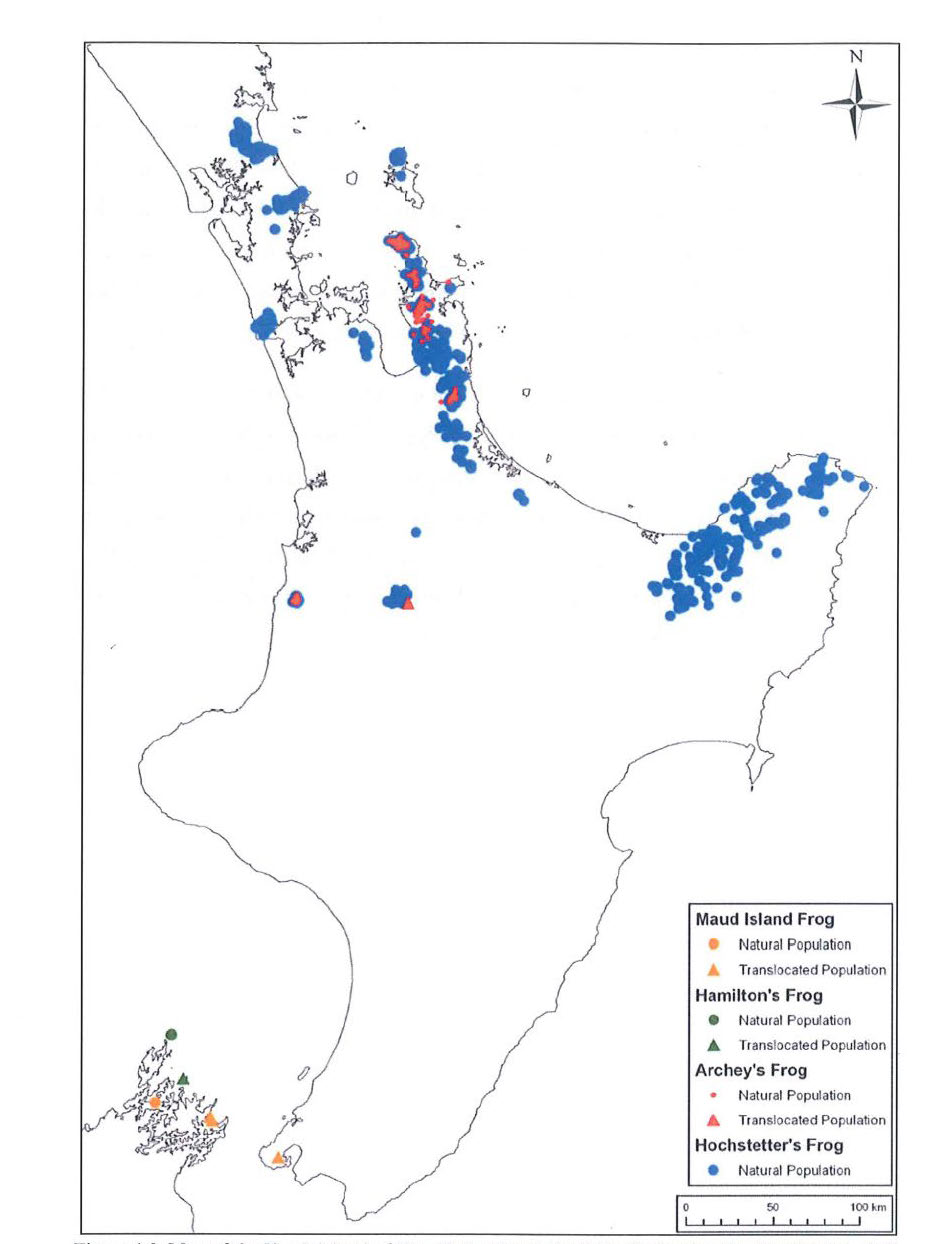
1982
Act
Information
Official
It has been proven that rat predation has a significant impact on Archey’s frog populations, and that
rat control has a positive impact (see Whareorino research).
the
Iconic species
In addition to high priority threatened species, there are also iconic species throughout the block,
the Moehau stag beetle, is one of the more unusual species that inhabit the mountain
.
under
Kauri
The Moehau ecological area includes impressive stands of Kauri. Kauri are a significant species,
influencing community species composition through alterations to soil chemistry. Kauri are under
threat from kauri dieback disease (Phytophthora Taxon Agathis), which has recently been confirmed
on the Coromandel for the first time.
Freshwater fish
Native freshwater fish have been recorded throughout the several catchments in the operational
Released
area including short jawed kokopu, banded kokopu, inanga, long finned and short finned eels, koura,
torrent fish and red finned bullies inhabit the streams.
14
Moehau Moehau Operational plan
Threats
Animal pest species present in the reserve are stoat, weasel, Norway rat, ship rat, mouse, hedgehog,
cat, pig, rabbit and possum.
Introduced pests are having major impacts on Moehau flora and fauna. Possums are causing
mortality of canopy trees like rata and kohekohe through defoliation. Possums have been managed
since 1989 with trapping starting in Port Jackson and then moving southward. The first toxin used
between 1995 and 2000 was brodifacoum in bait stations set out on a grid approximately 150m
apart. DOC discontinued the use of brodifacoum in 2000 and possums have been control ed around
parts of Moehau using other toxins approximately every 4 years, with a first aerial application of
1982
1080 in 2012 over 4500ha achieving a result of 0% RTC.
Ship rats are abundant and together with mice, are opportunists, eating both vegetation and animal
matter. Rats predate heavily on Weta, beetles, spiders, moths, stick insects, cicadas, native snails
Act
and frogs, slugs, and lizards. Seasonal food includes bird eggs and chicks. Rat numbers increased on
Moehau once Mustelid trapping was initiated in 1995, rat control begun with trapping using victor
traps in northern stony bay in 2002 and 2003 (Murphy 2004) fol owed by Diphacinone in bait
stations laid on a grid approximately 75m apart in 2004. Since then low rat numbers have been
maintained at Stony Bay using a 75m grid system over 1500 ha (reduced to 600ha in 2015 and then
increased to 1000ha in 2017) using toxins including 1080.
Mustelids (weasels, ferrets and stoats) and feral cats are present. All four species threaten
conservation values by preying on vertebrate and invertebrate populations, but the most destructive
Information
is the stoat. Stoats are adept tree climbers and, along with ship rats, will predate birds, nestlings,
eggs, lizards and invertebrates within the canopy.
Mustelid especially stoats are affecting kiwi through chick predation, in 2000 a trapping grid was set
up on Moehau covering approximately 1800hec, 1600 traps are laid 200m apart on selected ridges,
roads etc. Since trapping was introduced to Moehau kiwi chick survival has averaged 77% of all
Official
chicks produced by tagged Kiwis over the years 2000 to 2005. (De Monchy2005).
Hedgehogs are also present, mainly preying on native invertebrates. The extent to which hedgehogs,
rodents and pigs affect snails at this site is unknown.
the
Goats were first control ed by government hunters on Moehau in 1956 but sustained control at
regular intervals did not occur until 1981 with their final removal occurring in 2005, since then only a
couple of goats have been shot and their presence or how they got there was unknown, but most
likely from neighbouring farms.
under
Cattle from neighbouring farms have historically grazed the accessible parts of Moehau have caused
considerable damage to the understorey. In the last 10 years, boundary fences have been erected
around most of the mountain except in the south west corner made up of the Tehope, Ongohi and
Urarima catchments. Grazing is still occurring in parts of these areas and a completed boundary
fence around Moehau wil be a longer-term goal.
Cats are controlled around Moehau to protect Pateke from predation, 43 traps have been
Released
maintained since April 2011.
Pigs are present on Moehau and cause damage to the forest ecosystem. A seasonal ballot has been
the control method for pigs in recent years.
15
Moehau Moehau Operational plan
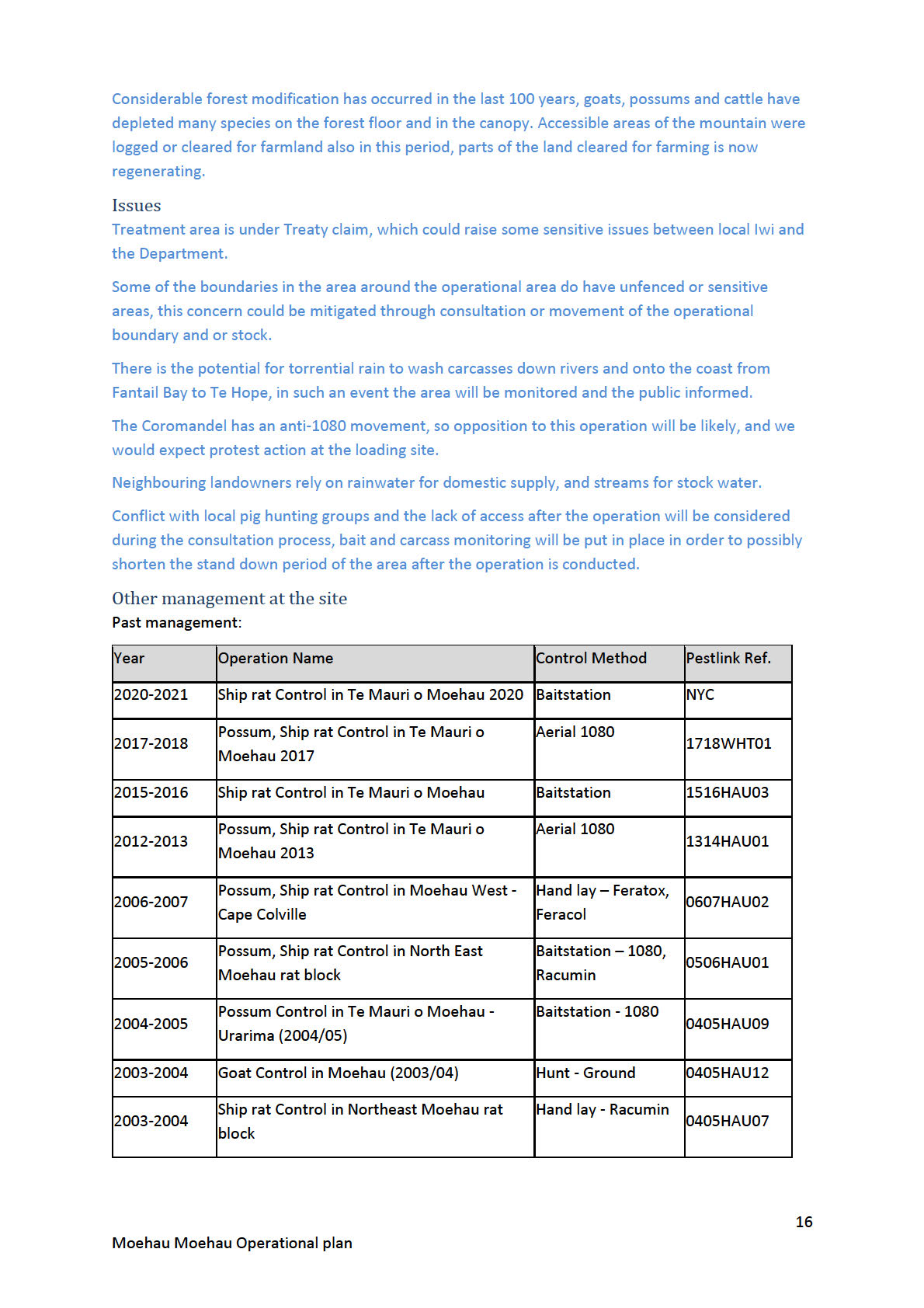
1982
Act
Information
Official
the
under
Released
Baitstation –
Ship rat Control in Northeast Moehau rat
2003-2004
Diphacinone
0405HAU06
block (2003/04)
Hand lay - Racumin
2002-2003
Goat Control in Moehau (2002/03)
Hunt - Ground
0405HAU10
Ship rat Control in Northeast Moehau rat
Trap - Kill
2002-2003
0405HAU05
block (2002/03)
Possum Control in Te Mauri o Moehau
Baitstation - Feratox
2002-2003
0304HAU03
(2002/03)
1982
Ship rat Control in Te Mauri o Moehau -
Trap - Kill
2002-2003
0203HAU22
Poley Shag Bay/Stock Track
Act
Possum Control in Te Mauri o Moehau
Baitstation - Feratox
2001-2002
0809HAU02
2001/02
Possum Control in Te Mauri o Moehau -
Hand lay – Cyanide
2000-2001
0405HAU08
Urarima (2000/01)
Trap - leghold
2000-2001
Goat Control in Moehau 2000/01
Hunt - Ground
0203HAU31
Possum Control in Te Mauri o Moehau -
Baitstation - Talon
2000-2001
0203HAU13
Information
Western Block
Possum Control in Te Mauri o Moehau -
Baitstation - Feratox
2000-2001
0203HAU12
Fletchers Bay Block
Possum, Ship rat Control in Te Mauri o
Baitstation -
2000-2001
0203HAU01
Moehau - Mt Homebush
Cholecalciferol
Official
Possum Control in Te Mauri o Moehau-
Baitstation - Talon
1999-2000
0203HAU02
Eastern Block
the
1998-1999
Goat Control in Moehau 1998/99
Hunt - Ground
0203HAU32
Possum Control in Te Mauri o Moehau - Mt Baitstation - Talon
1998-1999
0203HAU14
Homebush-Fletcher Bay/Ongohi
under
Possum Control in Te Mauri o Moehau
Baitstation - Talon
1997-1998
0304HAU12
(1997/98)
1997-1998
Goat Control in Moehau 1997/98
Hunt - Ground
0203HAU41
1996-1997
Goat Control in Moehau 1996/97
Hunt - Ground
0203HAU42
1995-1996
Goat Control in Moehau 1987 - 1996
Hunt - Ground
0203HAU43
Released
1986-1987
Goat Control in Moehau 1979 - 1986
Hunt - Ground
0203HAU44
There is no other management planned for this site at this stage.
17
Moehau Moehau Operational plan
14. Control Design
This project is focussed on the aerial application of 1080 baits over the treatment area of 4,674ha.
Toxic bait is aiming to be delivered in ideal weather conditions during the month of July/August 2021
and within 20 days of pre-feeding. This time has been chosen as the best time to conduct the
operation as possums and rats are more vulnerable to poisoning in winter/early spring where
alternative food sources are seasonally low. If delayed by bad weather a decision on the need to
repeat pre-feeding wil be taken beyond 40 days.
Future pest control operations in this area will depend on initial control levels achieved from this
operation and on the rate of re-invasion from adjacent areas. It is expected that the possum
1982
population wil take at least five years before they begin to have a measurable effect on the
indicator species. Aerial operations are planned to be carried out every four years over the next 50-
year period, with 800ha within the Moehau ecological area being treated for rats, occurring once
Act
yearly except the year of aerial treatment
One application of 1.5 kg (6 gram baits) per hectare of pre-feed cereal bait will be sown by helicopter
for the aerial operation. Following the pre-feed, 1080 will be applied at a rate of 1.5 kg (6 gram baits)
per hectare for the Moehau ecological area. The timing of the sowing of the 1080 baits will require a
weather window of three fine nights to achieve maximum toxin uptake.
15. Method(s)
Information
The pesticide uses are:
• 0.15% 1080 cereal pellets aerially applied.
Pre-feeding at 1.5kg/ha will be followed within 20 days by toxic baiting at the same rate.
Official
16. Block and treatment area boundaries
The Moehau treatment area is located at the northern tip of the Coromandel peninsula. The nearest
township is Colville, approximately 7 km south of the operational boundary and Coromandel Town is
the
55km by road. The operational area is approximately 4,674ha and has sea on the eastern boundary
and farmland (private and conservation concession) to the north and west. The Southern boundary
is in private ownership and consists largely of forested communally owned land and farms.
There are four DOC campgrounds adjacent to treatment area, 2 in the west, 1 in the north and 1 in
under
the east. The eastern campground Stony Bay wil be closed for the duration of the operation.
The road to the Stony Bay campground is a 7km windy gravel road owned by Thames-Coromandel
District council. Road is used by campers and leasee farmer. We will seek consent to have a 50m
buffer from Stony Bay road supported by trickle sowing.
The treatment boundaries are available in:
Q:\GIS_Users\Whitianga\Data\Biodiversity\Possum_Control\Moehau_Possum_Control\Aerial 2021-
Released
22\Shapefiles
9(2)(a)
9(2)(g)(ii)
18
Moehau Moehau Operational plan
There is a section of boundary in the south-west that is not fenced, the cattle graze the DOC forest
within the treatment area. Negotiation is required 9(2)(a)
to
remove the stock from these areas and graze alternate paddocks until caution period is over.
Sensitive boundary in the north 9(2)(g)(ii) that has stock wil have an 100m buffer supported by
trickle sowing.
9(2)(g)(ii)
1982
Act
Information
Official
the
under
Released
19
Moehau Moehau Operational plan
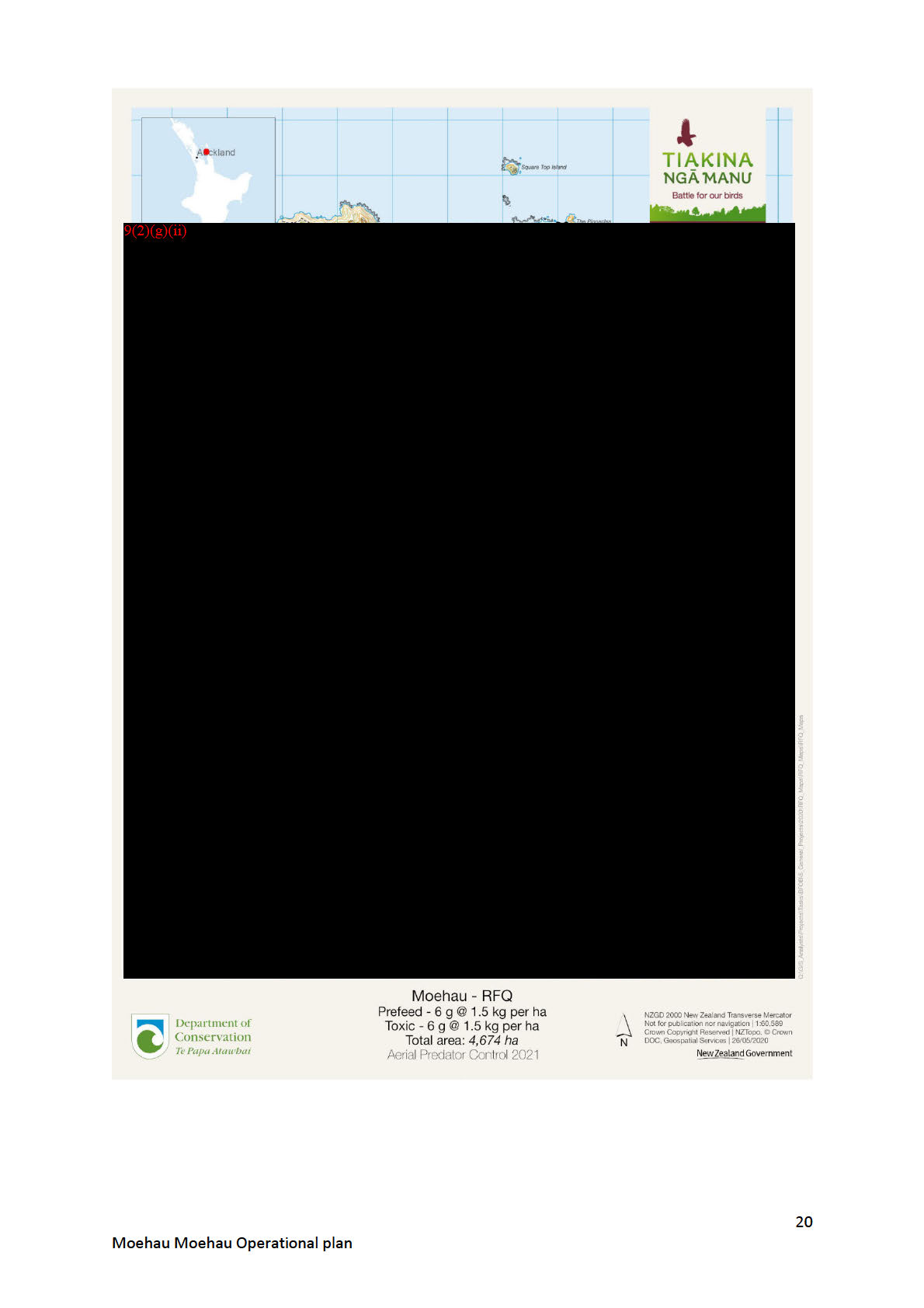
1982
Act
Information
Official
the
under
Released
17. Loading sites & other set up
9(2)(g)(ii)
An incident control point will be established in a caravan located within sight of loading operations.
18. Security
1982
9(2)(g)(ii)
have been engaged to provide loading site security on days of bait application and to
act as security consultants throughout the planning of the operation. 9(2)(g)(ii)
Act
19. Public safety
The communication plan outlines all the target audiences for notification about the operation. The
record contained within that plan shows who was contacted when and by what means. A public
notice in the Hauraki Herald will be placed two weeks before our target start date. Warning signs will
be erected as per the sign register in the Pesticides App at least the day before toxic bait is laid.
Stony Bay campground wil be closed for the duration of the operation. There are three public
Information
walking tracks within the treatment area, Fantail Bay track, Stony Bay mountain bike track and the
Coastal walkway track. The coastal walkway and Mountain bike track will be closed during the toxic
bait application and baits will be cleared from all tracks as soon as practical after toxic baiting.
9(2)(g)(ii)
Official
There are two campgrounds which take their water from within the treatment area and are with the
3km radius, these water supplies will be disconnected.
the
• Stony Bay campground
• Fantail Bay campground
under
20. Bait, storage and transport
Bait Type
This project will use 0.15% 1080 Pellets using RS5 16mm (6 g) baits. Baits will be ‘double’ cinnamon
lured (0.3%). A total of 7.8 tonne of prefeed and 7.8 tonne of toxic bait is required for this operation.
Prefeed bait is required to be in 9(2)(g)(ii)
store by 1st July with toxic available by 25th July. Bait
will be bulk packaged in 300kg bags with 2 bags per pallet.
Released
21
Moehau Moehau Operational plan
Bait Transport
Bait will be loaded by forklift from 9(2)(g)(ii)
store onto 9(2)(g)(ii) truck and trailer the morning
prior to each application. 9(2)(g)(ii)
Loads will be covered by waterproof tarpaulins.
21. Incidents and emergencies
An emergency response plan wil be developed 9(2)(g)(ii) and wil be included in the Action Plan for
• Suspected poisoning
1982
• Over sows (Bait misapplication)
• Dropped bucket
• Fire
Act
• Medical emergency
• Unauthorised personal/public on loading site
• Mechanical issues
It also provides a generic template to guide establishing a response to other types of incidents not
covered.
This plan is intended as a starting point for modification using Team Process to adapt it to real
situations as they arise. A core emergency response team will remain on standby to respond to
incidents as they arise. This team wil be supplemented by others as required. The core team are
trained first aiders and hold CSL’s for 1080. The over sow scenario will be practiced during the
Information
prefeed baiting.
22. Decision making on the day of bait application
The decision to begin or stop flying operations on the day of operation will follow a 3 yes- 1 no
Official
protocol. To begin requires the concurrence of the Incident Controller, Project Manager Lead and
the Chief Pilot. Any one of these three or the Air Operations Manager or Safety Officer will be able to
stop operations if they see an issue which warrants it.
the
Other decisions will be taken by the relevant managers in the operational team described in section
4 of this plan or by the Incident Controller. Decisions within the scope of delegated tasks will fall to
those people delegated the task.
under
23. Bait spreading
Pre-feeding
Pre-feeding using non-toxic RS5 cinnamon lured 16mm (6g) bait will begin in the first suitable
weather window on or after 1st July. Pre-feed baits will be sown at a rate of 1.5kg/ha using 9(2)(g)(ii)
helicopters taking loads of 600kg. 9(2)(g)(ii) sowing buckets
have a calibrated useable swath width of 180m so GPS flight lines will use this spacing.
Released
22
Moehau Moehau Operational plan
Toxic Baiting
Toxic baiting will follow at the first available weather opportunity at least 10 days after pre-feeding.
Toxic bait will be sown at 1.5kg/ha. A forecast of at least 2 fine nights with less than 10mm
accumulated rainfall for that period will be required.
Bait loading
Despite using non-toxic baits the loading of pre-feed will be treated as a ‘dress rehearsal’ for toxic
baiting so loading crews will wear full PPE as per Safe Handling Sheet 1. 9(2)(g)(ii) will supply a loader
and driver, baits wil be loaded by a 5 person9(2)(g)(ii) team off the truck and trailer. The loading
1982
system will be debriefed at the end of pre-feeding and improvements made for the toxic baiting.
Act
Data capture
Helicopter GPS data will be downloaded from each machine immediately after the first load and
thereafter at refuelling times (approximately hourly). Downloads will be processed by the GIS
Analyst and discussed with Air Operations Manager and from time to time the Incident Controller.
A bait log will be kept for each load leaving the loading site. This data will be precisely timed so that
it can be matched with GPS downloads. Additional record keeping wil include:
Information
• An operational log of personnel on site, weather reports and records, decisions taken by
Incident Controller
• Tracking of 1080 bait packages as they are received from the poison store and used on the
operation.
• A log of all communications and actions during and incident should one occur.
Official
24. Demobilisation
Clean up and disposal
the
Empty bags wil be bundled into wool fadges on site and returned to the 9(2)(g)(ii)
store for later
disposal. The 9(2)(g)(ii)
truck decks wil be inspected and swept before back-loading empty
pal ets and bags to the 9(2)(g)(ii)
store at the completion of toxic baiting. The helicopter bucket
and loader will be washed down with high pressure water after first removing any visible pellets
remaining. The loading site itself will be fenced off and washed down with high pressure water.
under
Fencing and loading site signs will remain in place until 50mm of rain has fallen on the site.
Contaminated PPE wil be either disposed with empty toxic bait bags or labelled and returned to
9(2)(g)(ii)
store for cleaning.
Released
23
Moehau Moehau Operational plan
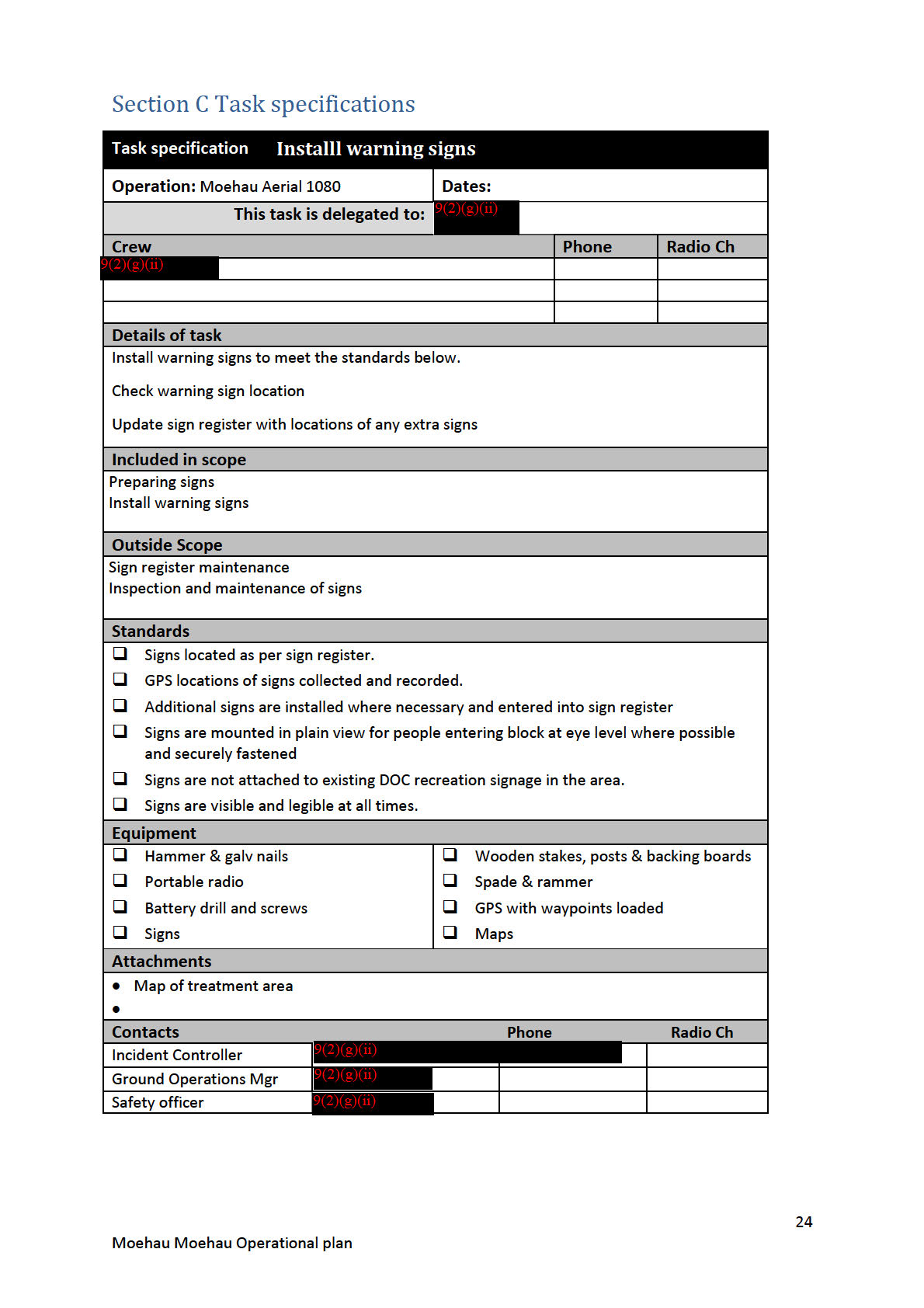
1982
Act
Information
Official
the
under
Released
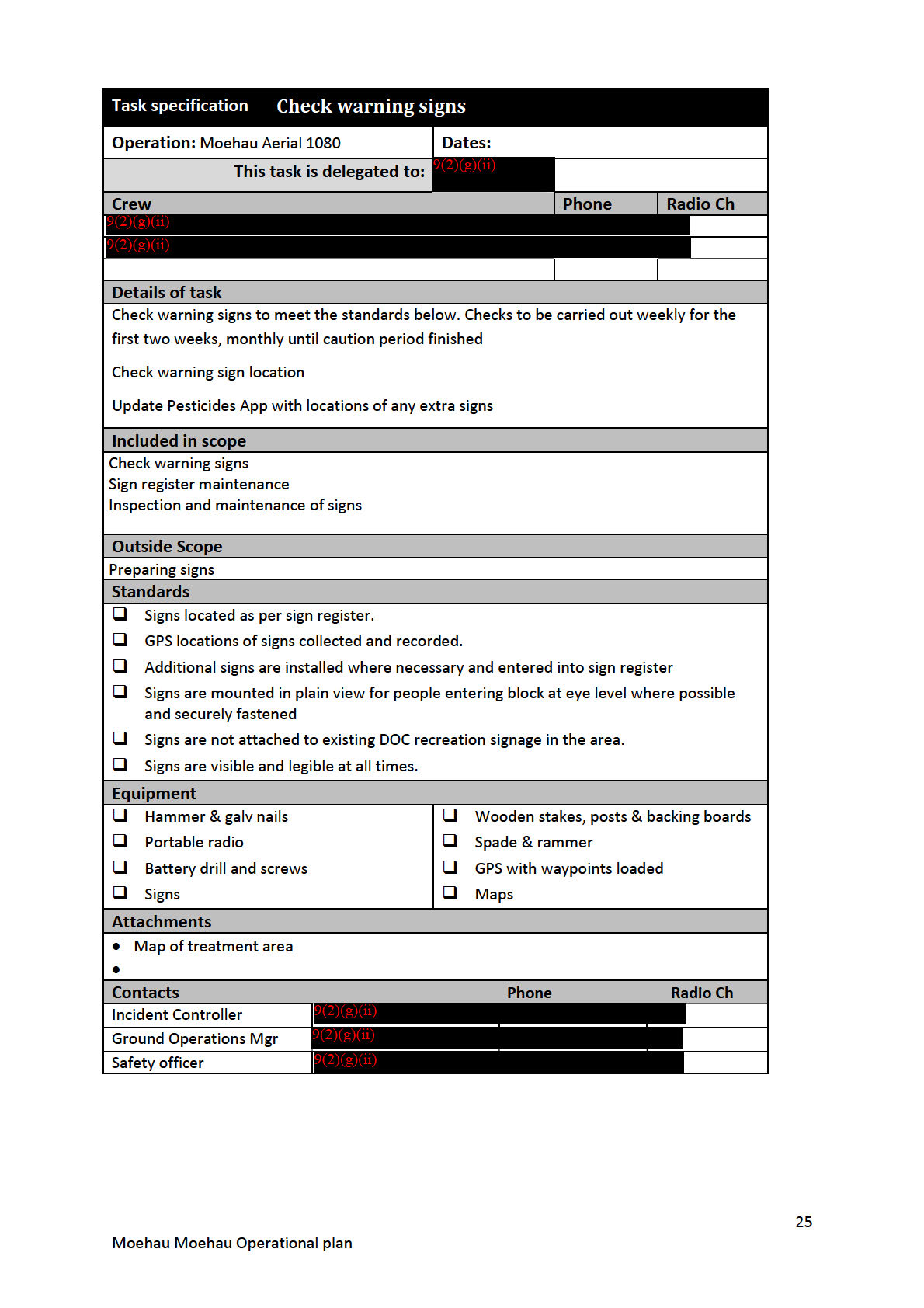
1982
Act
Information
Official
the
under
Released
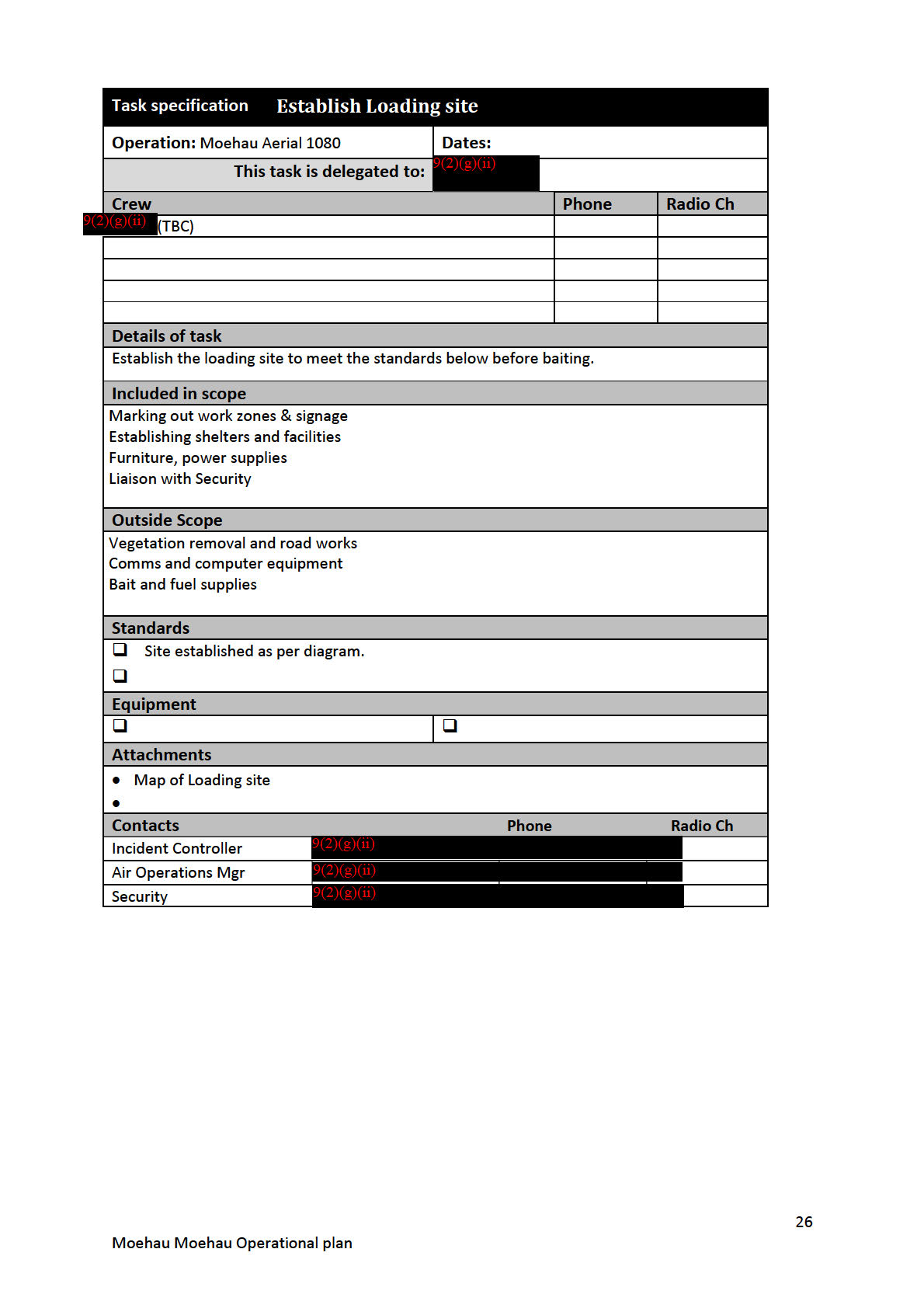
1982
Act
Information
Official
the
under
Released
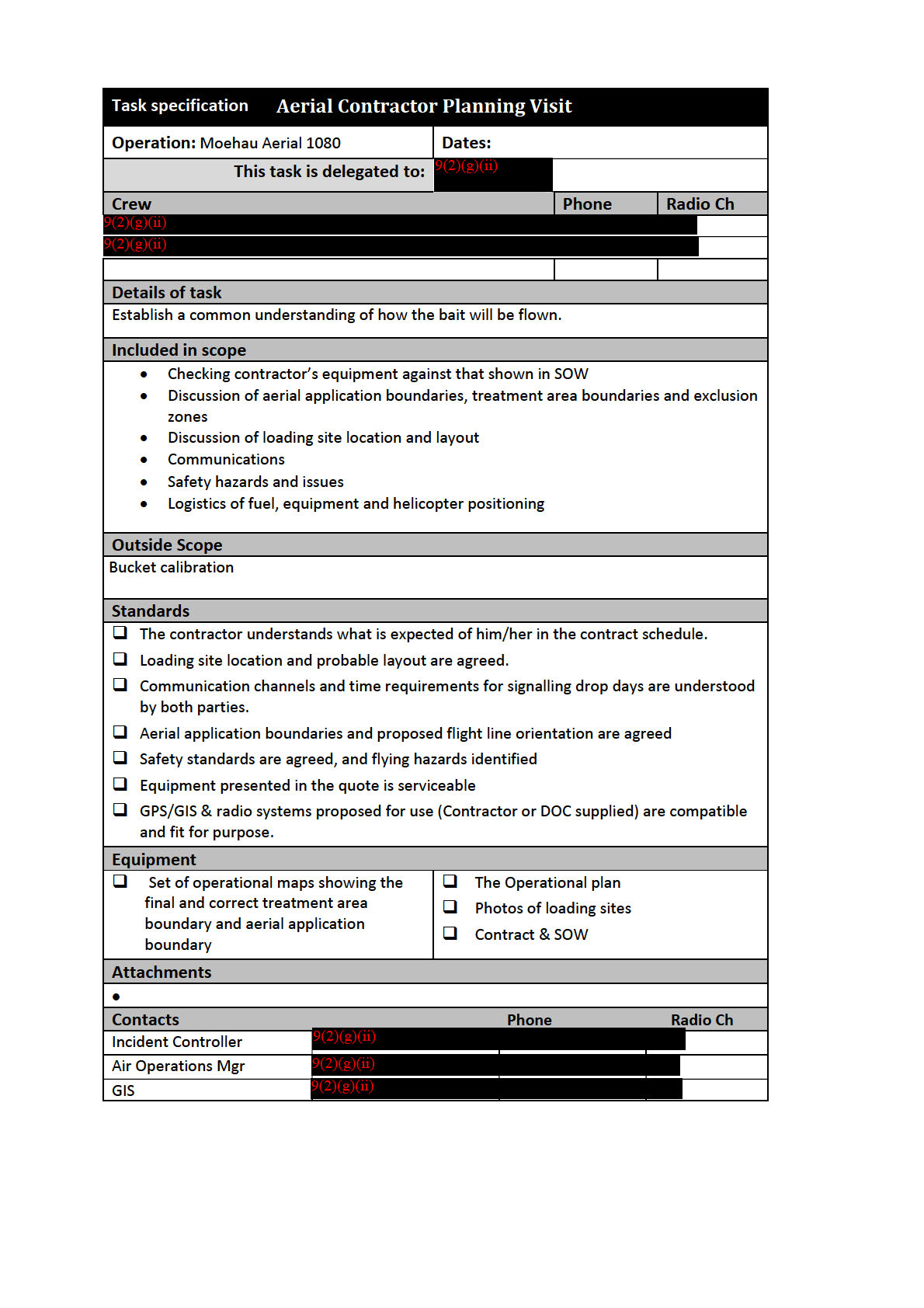
1982
Act
Information
Official
the
under
Released
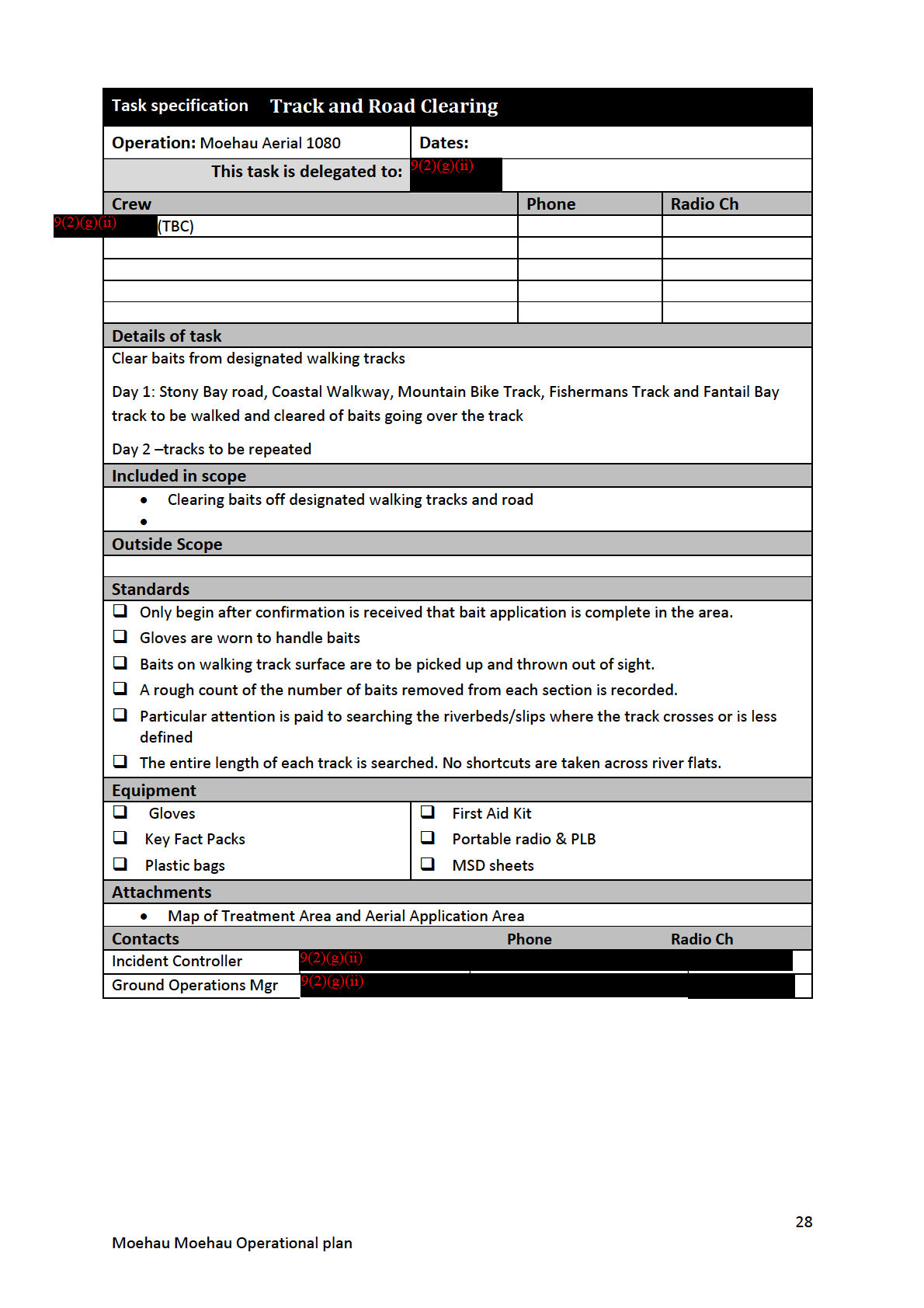
1982
Act
Information
Official
the
under
Released
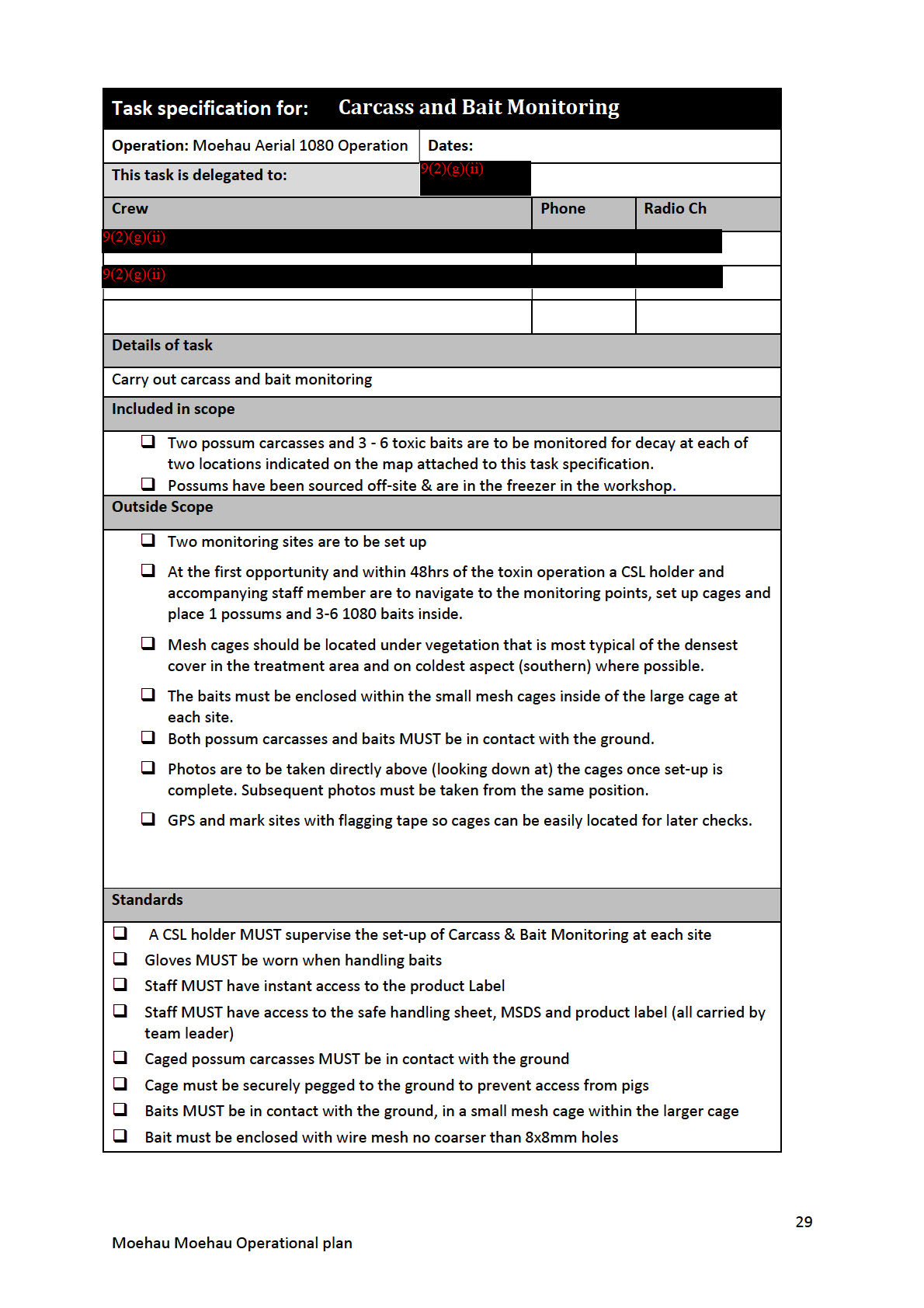
1982
Act
Information
Official
the
under
Released
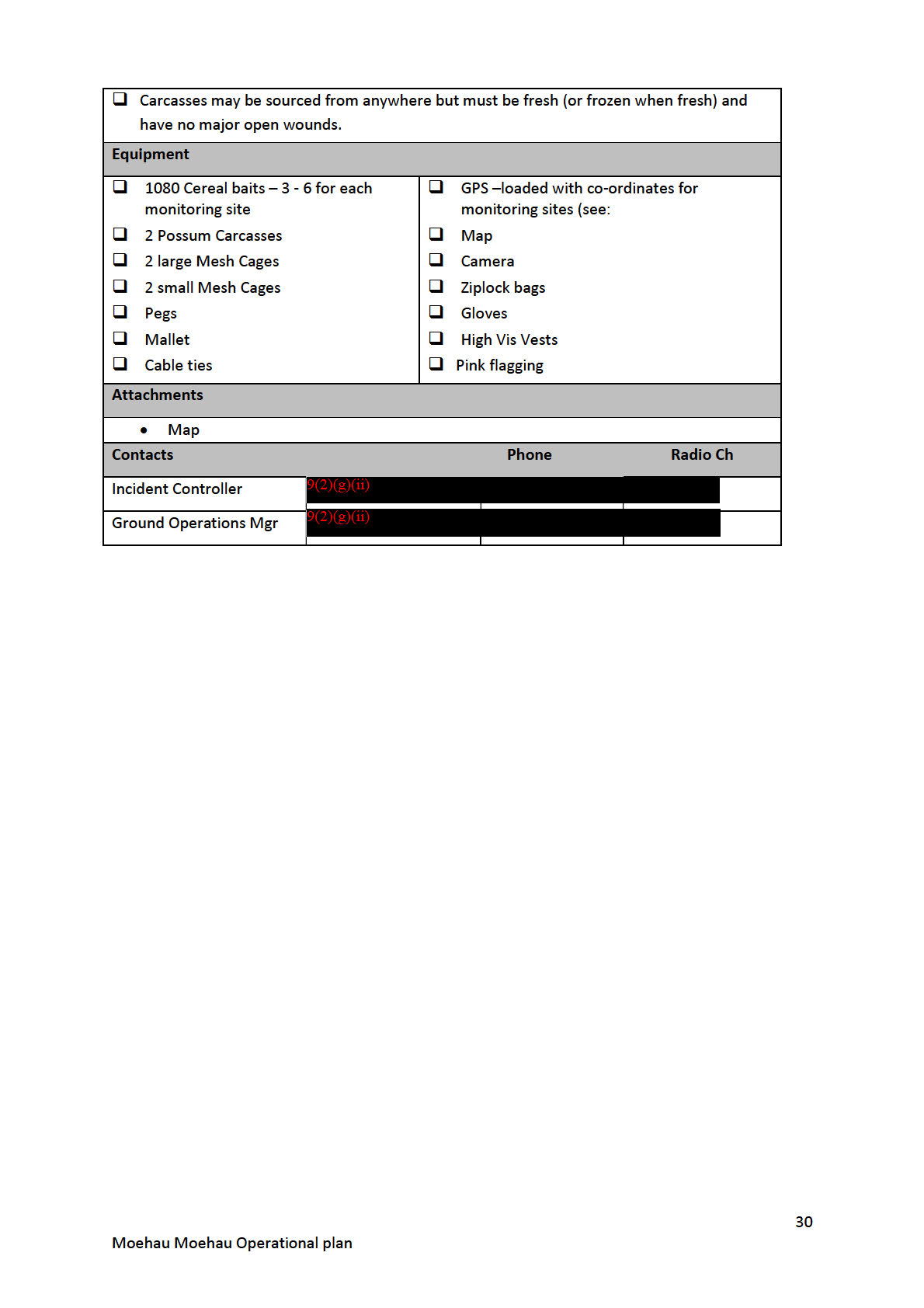
1982
Act
Information
Official
the
under
Released















